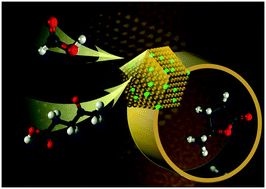Supported gold–nickel nano-alloy as a highly efficient catalyst in levulinic acid hydrogenation with formic acid as an internal hydrogen source†
Abstract
Gamma-valerolactone (GVL) is one of the key products of future biorefineries. We show here for the first time the superior activity of Ni-based, Au doped catalysts in levulinic acid hydrogenation towards GVL using formic acid as a hydrogen source. Their performances are strongly influenced by the preparation method, and the highest GVL yield is achieved for bimetallic Au–Ni catalysts prepared via co-impregnation of both metallic salts with a reductive thermal treatment under hydrogen. The very high catalytic activity is explained by the use of DFT calculations and the extensive characterization of the catalyst surface and bulk properties. We highlight the pivotal role played by the incorporated isolated metallic Ni atoms within Au nanoparticles. The nano-alloy composition is determined. It allows establishment of a surface model of such an alloy, thanks to which the high activity can be explained by the presence of an optimum energetic span of FA adsorption. The existence of strong interaction between Au and Ni in a surface alloy, Au–Ni, favors selective and fast decomposition of formic acid into hydrogen that consequently facilitates strongly the combined hydrogenation process.



 Please wait while we load your content...
Please wait while we load your content...